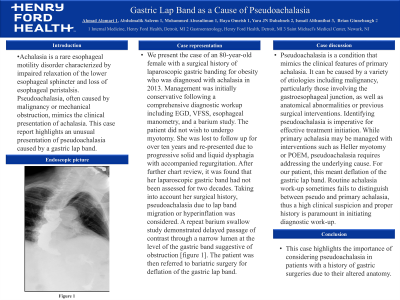Monday Poster Session
Category: Esophagus
P2309 - Gastric Lap Band as a Cause of Pseudoachalasia
Monday, October 28, 2024
10:30 AM - 4:00 PM ET
Location: Exhibit Hall E

Has Audio

Ahmad Alomari, MD
Henry Ford Hospital
Detroit, MI
Presenting Author(s)
Ahmad Alomari, MD1, Abdulmalik Saleem, MD2, Mohammed Abusuliman, MD2, Haya Omeish, MD2, Yara JN. Dababneh, MD2, Ismail Althunibat, MD3, Brian Ginnebaugh, MS, MD2
1Henry Ford Hospital, Detroit, MI; 2Henry Ford Health, Detroit, MI; 3Saint Michael's Medical Center, Newark, NJ
Introduction: Achalasia is a rare esophageal motility disorder characterized by impaired relaxation of the lower esophageal sphincter and loss of esophageal peristalsis. Pseudoachalasia, often caused by malignancy or mechanical obstruction, mimics the clinical presentation of achalasia. [1] This case report highlights an unusual presentation of pseudoachalasia caused by a gastric lap band.
Case Description/Methods: We present the case of an 80-year-old female with a surgical history of laparoscopic gastric banding for obesity who was diagnosed with achalasia in 2013. Management was initially conservative following a comprehensive diagnostic workup including EGD, VFSS, esophageal manometry, and a barium study. The patient did not wish to undergo myotomy. She was lost to follow up for over ten years and re-presented due to progressive solid and liquid dysphagia with accompanied regurgitation. After further chart review, it was found that her laparoscopic gastric band had not been assessed for two decades. Taking into account her surgical history, pseudoachalasia due to lap band migration or hyperinflation was considered. A repeat barium swallow study demonstrated delayed passage of contrast through a narrow lumen at the level of the gastric band suggestive of obstruction [figure 1]. The patient was then referred to bariatric surgery for deflation of the gastric lap band.
Discussion: Pseudoachalasia is a condition that mimics the clinical features of primary achalasia. It can be caused by a variety of etiologies including malignancy, particularly those involving the gastroesophageal junction, as well as anatomical abnormalities or previous surgical interventions. Identifying pseudoachalasia is imperative for effective treatment initiation. While primary achalasia may be managed with interventions such as Heller myotomy or POEM, pseudoachalasia requires addressing the underlying cause. For our patient, this meant deflation of the gastric lap band. Routine achalasia work-up sometimes fails to distinguish between pseudo and primary achalasia, thus a high clinical suspicion and proper history is paramount in initiating diagnostic work-up. This case highlights the importance of considering pseudoachalasia in patients with a history of gastric surgeries due to their altered anatomy.
Disclosures:
Ahmad Alomari, MD1, Abdulmalik Saleem, MD2, Mohammed Abusuliman, MD2, Haya Omeish, MD2, Yara JN. Dababneh, MD2, Ismail Althunibat, MD3, Brian Ginnebaugh, MS, MD2. P2309 - Gastric Lap Band as a Cause of Pseudoachalasia, ACG 2024 Annual Scientific Meeting Abstracts. Philadelphia, PA: American College of Gastroenterology.
1Henry Ford Hospital, Detroit, MI; 2Henry Ford Health, Detroit, MI; 3Saint Michael's Medical Center, Newark, NJ
Introduction: Achalasia is a rare esophageal motility disorder characterized by impaired relaxation of the lower esophageal sphincter and loss of esophageal peristalsis. Pseudoachalasia, often caused by malignancy or mechanical obstruction, mimics the clinical presentation of achalasia. [1] This case report highlights an unusual presentation of pseudoachalasia caused by a gastric lap band.
Case Description/Methods: We present the case of an 80-year-old female with a surgical history of laparoscopic gastric banding for obesity who was diagnosed with achalasia in 2013. Management was initially conservative following a comprehensive diagnostic workup including EGD, VFSS, esophageal manometry, and a barium study. The patient did not wish to undergo myotomy. She was lost to follow up for over ten years and re-presented due to progressive solid and liquid dysphagia with accompanied regurgitation. After further chart review, it was found that her laparoscopic gastric band had not been assessed for two decades. Taking into account her surgical history, pseudoachalasia due to lap band migration or hyperinflation was considered. A repeat barium swallow study demonstrated delayed passage of contrast through a narrow lumen at the level of the gastric band suggestive of obstruction [figure 1]. The patient was then referred to bariatric surgery for deflation of the gastric lap band.
Discussion: Pseudoachalasia is a condition that mimics the clinical features of primary achalasia. It can be caused by a variety of etiologies including malignancy, particularly those involving the gastroesophageal junction, as well as anatomical abnormalities or previous surgical interventions. Identifying pseudoachalasia is imperative for effective treatment initiation. While primary achalasia may be managed with interventions such as Heller myotomy or POEM, pseudoachalasia requires addressing the underlying cause. For our patient, this meant deflation of the gastric lap band. Routine achalasia work-up sometimes fails to distinguish between pseudo and primary achalasia, thus a high clinical suspicion and proper history is paramount in initiating diagnostic work-up. This case highlights the importance of considering pseudoachalasia in patients with a history of gastric surgeries due to their altered anatomy.
Disclosures:
Ahmad Alomari indicated no relevant financial relationships.
Abdulmalik Saleem indicated no relevant financial relationships.
Mohammed Abusuliman indicated no relevant financial relationships.
Haya Omeish indicated no relevant financial relationships.
Yara Dababneh indicated no relevant financial relationships.
Ismail Althunibat indicated no relevant financial relationships.
Brian Ginnebaugh indicated no relevant financial relationships.
Ahmad Alomari, MD1, Abdulmalik Saleem, MD2, Mohammed Abusuliman, MD2, Haya Omeish, MD2, Yara JN. Dababneh, MD2, Ismail Althunibat, MD3, Brian Ginnebaugh, MS, MD2. P2309 - Gastric Lap Band as a Cause of Pseudoachalasia, ACG 2024 Annual Scientific Meeting Abstracts. Philadelphia, PA: American College of Gastroenterology.
